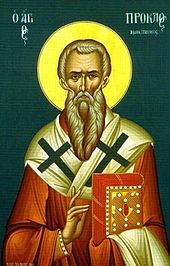Proclus of Constantinople

Proclus of Constantinople , Greek Πρόκλος , Latin Proclus (* around 390; † 446 or 447 in Constantinople ), was Archbishop of Constantinople from 434 to 446. He is venerated as a saint in the Orthodox and Roman Catholic Churches . His feast day is November 20th.
Life
The main source for the biography of Proclus is the church history of Socrates Scholastikos († around 440). According to this, Proclus was a lecturer in Constantinople as a very young man , studied rhetoric with important teachers and became secretary to Archbishop Atticus , who ordained him as a deacon and priest .
When Atticus died in 425, many would have liked to see him as his successor, but the choice fell on Sisinnius . This appointed Proclus archbishop of Kyzikos in Mysia . There, however, they wanted a bishop from their own ranks, and Proklos did not take up the office.
After Sisinnius' death in 427 and after the deposition of his successor Nestorius by the Council of Ephesus in 431, Proclus was again considered a candidate for successor, but was again passed over. During the episcopate of Nestorius, Proclus gave a sermon in which he defended the title of Mary Theotokos , for which he was reprimanded by Nestorius. It was only when Nestorius' successor Maximian died in 434, after only three years in office, that Proclus was appointed as his successor immediately, even before Maximian's funeral.
In the christological disputes of the time, Proclus was characterized, according to Socrates Scholastikos, by dogmatically uncompromising, but humanly conciliatory approach. When asked by Armenian bishops about some of the doctrines attributed to Theodor of Mopsuestia , he condemned them, but denied that Theodor was the author, who was highly valued by the Armenians.
In 438 Proclus had the relics of John Chrysostom, who died in exile in 407, solemnly transferred to Constantinople and buried in the Apostle Church .
Legend
Proclus posthumously rehabilitated Saint John Chrysostom, and Proclus' name is associated with the introduction of the Trisagion into the Byzantine liturgy . Both facts were elaborated in legend. Proclus is said to have been a pupil of Chrysostom as a boy and thereby witnessed the appearance of the apostle Paul ; Chrysostom also gave him orders. The Trisagion was revealed during a series of severe earthquakes. During a petition led by the Archbishop, a boy was raised to heaven by an invisible hand and, after his return, reported how the angels sang the Trisagion. The people have taken up this hymn of praise and expanded it to include the cry “Have mercy on us!”. Then the tremors stopped.
literature
- Franz Xaver Bauer: Proclus of Constantinople. A contribution to the church u. History of dogmas of the 5th century (= publications from the Church History Seminar Munich, IV. Series, No. 8), Munich 1919
- François Joseph Leroy: L'homilétique de Proclus de Constantinople. Tradition manuscrite, inédits, études connexes (Studi e Testi 247), Città del Vaticano 1967.
Web links
- St. Proclus ( Catholic Encyclopedia , English)
- Proclus on the website of the Ecumenical Patriarchate
- St Proclus the Archbishop of Constantinople on the pages of the Orthodox Church in America
- Hagiologion for November 20th (Greek)
- Legend (stjosephmelkitecatholicchurch.org, English)
Individual evidence
- ^ Proclus was the penultimate archbishop before Constantinople was elevated to patriarchy by the Council of Chalcedon in 451; he is therefore often called the patriarch .
| predecessor | Office | successor |
|---|---|---|
| Maximianus |
Archbishop of Constantinople 434–446 |
Flavianus |
| personal data | |
|---|---|
| SURNAME | Proclus of Constantinople |
| ALTERNATIVE NAMES | Proclus |
| BRIEF DESCRIPTION | Archbishop of Constantinople |
| DATE OF BIRTH | 4th century |
| DATE OF DEATH | 446 or 447 |
| Place of death | Constantinople |